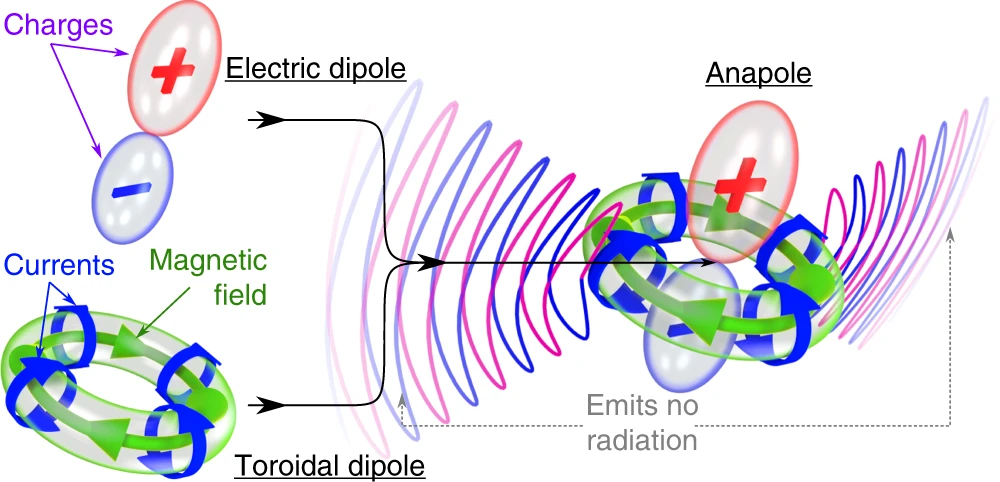Kerker anapoles
A nanoantenna with balanced electric and magnetic dipole moments exhibits a directive radiation pattern with zero backscattering. This is known as the first Kerker condition after Kerker, Wang, and Giles, who predicted in 1983 that, under plane wave illumination, magnetic spheres with equal relative permittivity and permeability radiate no light in the backscattering direction. They also concluded that, for certain permittivity and permeability relations for nanospheres, this zero optical light scattering condition happened in the forward direction.
Three decades later, a renewed version of these ideas was proposed for subwavelength dielectric spheres of high refractive index (HRI) materials, reinvigorating the interest on these light scattering conditions. Interestingly, the scattering properties of HRI nanospheres can be fully described by dipolar modes. At the first Kerker condition the electric and magnetic dipolar modes oscillate in phase with equal amplitude. This optical response drives to destructive interference between the scattered fields at the backscattering direction, which is commonly referred to as the zero optical backscattering condition.
However, most of these properties are absent for larger spheres under plane wave illumination. Now, a proposal to unravel these dipolar regimes for larger particles under the illumination of a pure dipolar field has been presented 1.
Interestingly, the zero optical backscattering condition and the conservation of the helicity of the incident beam are linked and fully determined by the asymmetry parameter (g-parameter) in the dipolar regime. This magnitude has been widely employed in standard scattering theory to describe the directionality of the electromagnetic fields emitted by particles under study. As a matter of fact, and at the first Kerker condition, helicity conservation and g-parameter maximization (g = 0.5) occur simultaneously, leading to the absence of backscattered light for nanospheres in the dipolar regime.
The g-parameter may also be used as a signature of pure electric (or magnetic) HRI dipolar scatterers, as these cases would necessarily lead to symmetrical scattering, namely, g = 0. In this scenario, the amplitude of the electric (or magnetic) dipolar mode may vanish, and hence, dipolar scattered light vanishes accordingly. In this case, it is still possible to have internal electromagnetic energy. These particular optical states,are often referred to as anapoles (see Figure 1).

However, it is still challenging to obtain anapoles for the most studied phenomenon in the scattering of light: a homogeneous sphere under plane wave illumination. This difficulty arises from the inevitable contribution of higher multipolar orders in the scattering of a sphere. The simultaneous suppression of the electric and magnetic dipolar scattering efficiencies for larger spheres, at the so-called hybrid anapole, it is an open problem.
A team of researchers shows that dipolar spectral regimes can be induced in nano- and microsized dielectric spheres by illuminating with a pure dipolar field. This illumination does not excite higher multipolar orders, and hence, in analogy to HRI spheres in the limit of small particle, the scattering can be tuned from almost zero forward to perfect zero backscattering.

In the process, the team unravels the so-called hybrid anapole for several nano- and microsized dielectric spheres behaving dipolarly, unveiling a hidden connection with the first Kerker condition. As a result, the researchers name these particular non-radiating states, characterized by zero scattering and an enhanced internal electromagnetic energy, as Kerker anapoles.
Importantly, it is shown that all these new scattering features are reproducible with an experimentally accessible Gaussian beam, tightly-focused by commercial microscopic objectives, that could mimic the scattering features produced by these pure dipolar fields. These findings could drive new experiments in HRI materials beyond the limits of small particles.
Author: César Tomé López is a science writer and the editor of Mapping Ignorance
Disclaimer: Parts of this article may be copied verbatim or almost verbatim from the referenced research paper.
References
- Sanz-Fernández, C., Molezuelas-Ferreras, M., Lasa-Alonso, J., de, N., Zambrana-Puyalto, X., Olmos-Trigo, J. (2021) Multiple Kerker Anapoles in Dielectric Microspheres. Laser & Photonics Reviews doi: doi.org/10.1002/lpor.202100035 ↩